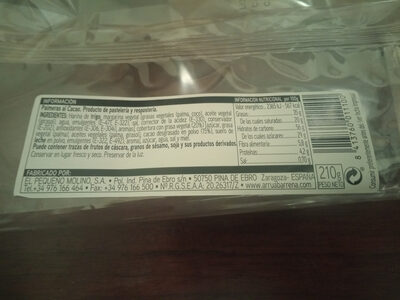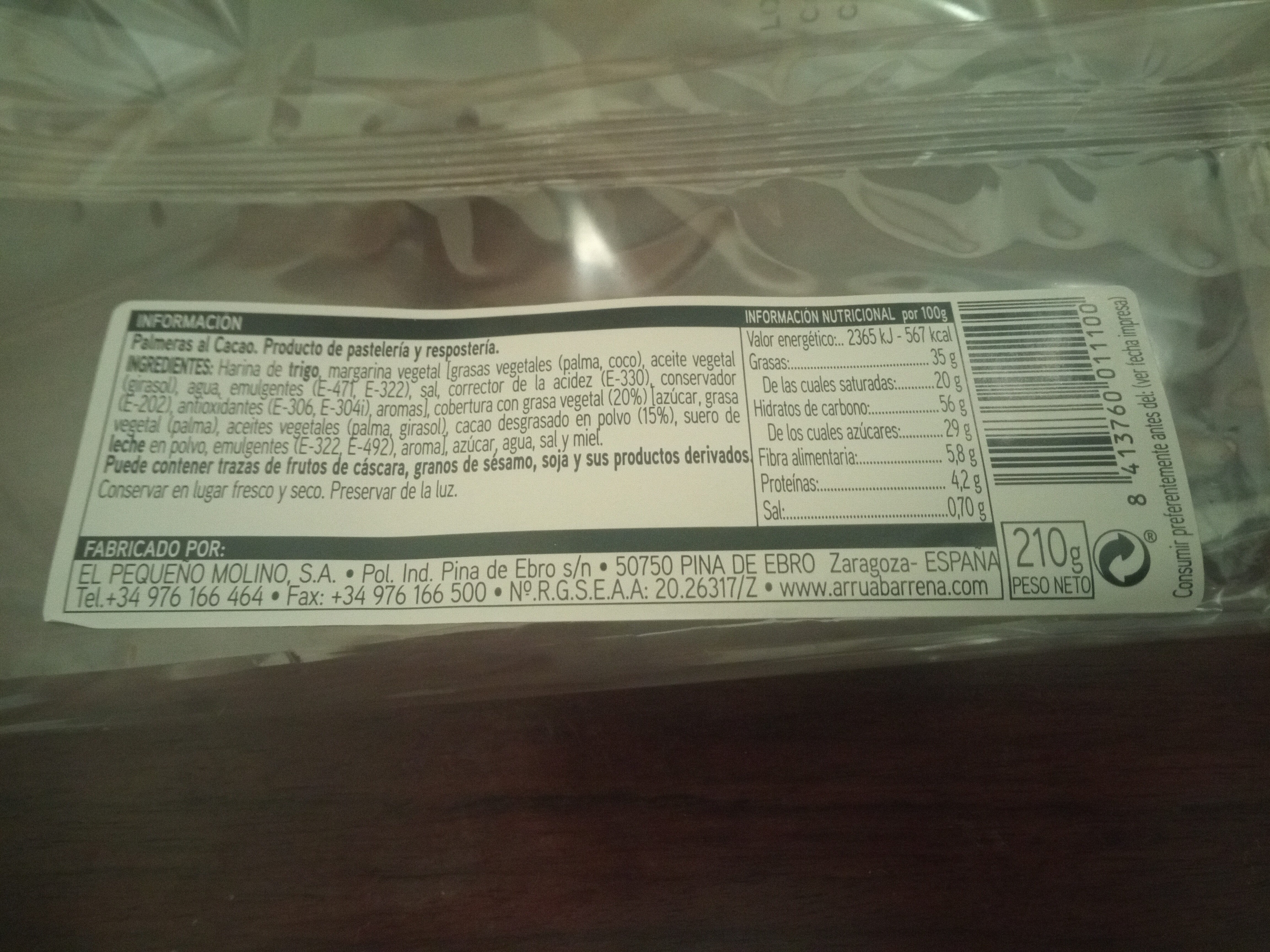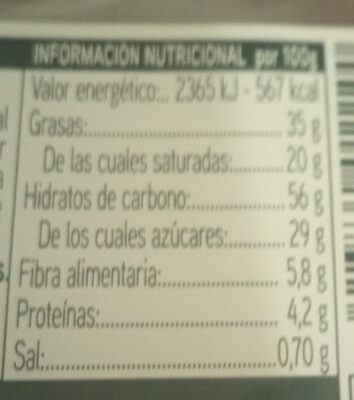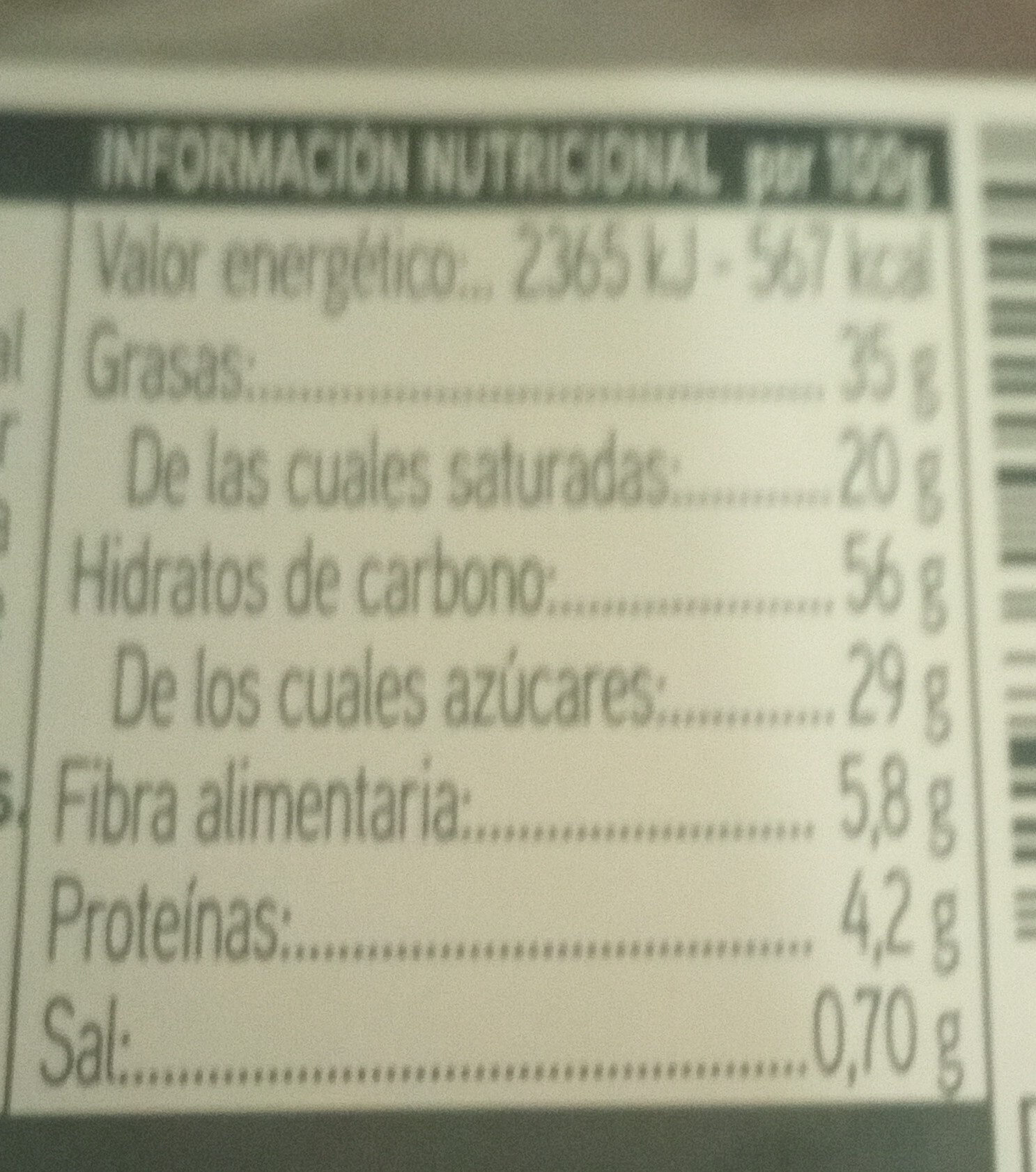Help us make food transparency the norm!
As a non-profit organization, we depend on your donations to continue informing consumers around the world about what they eat.
The food revolution starts with you!
Palmeras al cacao - - 210 g
Palmeras al cacao - - 210 g
This product page is not complete. You can help to complete it by editing it and adding more data from the photos we have, or by taking more photos using the app for Android or iPhone/iPad. Thank you!
×
Barra-kodea: 8413760011100 (EAN / EAN-13)
Kopurua: 210 g
Kategoriak: en:Snacks, en:Sweet snacks, en:Biscuits and cakes, Gaileta, en:Flaky biscuits, en:Palmiers
Manufacturing or processing places: Pina de Ebro, Zaragoza, España
Traceability code: 20.26317/Z
Link to the product page on the official site of the producer: http://www.arruabarrena.com
Saltzen diren herrialdeak: Espainia
Matching with your preferences
Health
Osagaiak
-
37 ingredients
: Harina de trigo, margarina vegetal [grasas vegetales (palma, coco), aceite vegetal (girasol), agua, emulgentes (E-471, E-322), sal, corrector de la acidez (E-330), conservador (E-202), antioxidantes (E-306, E-304i), aromas], cobertura con grasa vegetal (20%) [azúcar, grasa vegetal (palma), aceites vegetales (palma, girasol), cacao desgrasado en polvo (15%), suero de leche en polvo, emulgentes (E-332, E-492), aroma], azúcar, agua, sal y miel.Alergenoak: en:GlutenAztarnak: en:Nuts, en:Sesame seeds, en:Soybeans
Food processing
-
Ultra processed foods
Elements that indicate the product is in the 4 - Ultra prozesatutako elikagaiak eta edariak group:
- Gehigarria: E322
- Gehigarria: E471
- Gehigarria: E492
- Osagaia: Emulsifier
- Osagaia: Flavouring
- Osagaia: Esne-gazur
Food products are classified into 4 groups according to their degree of processing:
- Prozesatu gabeko edo ahalik eta gutxien prozesatutako elikagaiak
- Sukaldaritzako osagaiak prozesatu
- Prozesatutako jakiak
- Ultra processed foods
The determination of the group is based on the category of the product and on the ingredients it contains.
Gehigarriak
-
E202
Potassium sorbate: Potassium sorbate is the potassium salt of sorbic acid, chemical formula CH3CH=CH−CH=CH−CO2K. It is a white salt that is very soluble in water -58.2% at 20 °C-. It is primarily used as a food preservative -E number 202-. Potassium sorbate is effective in a variety of applications including food, wine, and personal-care products. While sorbic acid is naturally occurring in some berries, virtually all of the world's production of sorbic acid, from which potassium sorbate is derived, is manufactured synthetically.Source: Wikipedia (Ingeles)
-
E304
Ascorbyl palmitate: Ascorbyl palmitate is an ester formed from ascorbic acid and palmitic acid creating a fat-soluble form of vitamin C. In addition to its use as a source of vitamin C, it is also used as an antioxidant food additive -E number E304-. It is approved for use as a food additive in the EU, the U.S., Canada, Australia, and New Zealand.Ascorbyl palmitate is known to be broken down -through the digestive process- into ascorbic acid and palmitic acid -a saturated fatty acid- before being absorbed into the bloodstream. Ascorbyl palmitate is also marketed as "vitamin C ester".Source: Wikipedia (Ingeles)
-
E304i
Ascorbyl palmitate: Ascorbyl palmitate is an ester formed from ascorbic acid and palmitic acid creating a fat-soluble form of vitamin C. In addition to its use as a source of vitamin C, it is also used as an antioxidant food additive -E number E304-. It is approved for use as a food additive in the EU, the U.S., Canada, Australia, and New Zealand.Ascorbyl palmitate is known to be broken down -through the digestive process- into ascorbic acid and palmitic acid -a saturated fatty acid- before being absorbed into the bloodstream. Ascorbyl palmitate is also marketed as "vitamin C ester".Source: Wikipedia (Ingeles)
-
E322
Lecithin: Lecithin -UK: , US: , from the Greek lekithos, "egg yolk"- is a generic term to designate any group of yellow-brownish fatty substances occurring in animal and plant tissues, which are amphiphilic – they attract both water and fatty substances -and so are both hydrophilic and lipophilic-, and are used for smoothing food textures, dissolving powders -emulsifying-, homogenizing liquid mixtures, and repelling sticking materials.Lecithins are mixtures of glycerophospholipids including phosphatidylcholine, phosphatidylethanolamine, phosphatidylinositol, phosphatidylserine, and phosphatidic acid.Lecithin was first isolated in 1845 by the French chemist and pharmacist Theodore Gobley. In 1850, he named the phosphatidylcholine lécithine. Gobley originally isolated lecithin from egg yolk—λέκιθος lekithos is "egg yolk" in Ancient Greek—and established the complete chemical formula of phosphatidylcholine in 1874; in between, he had demonstrated the presence of lecithin in a variety of biological matters, including venous blood, in human lungs, bile, human brain tissue, fish eggs, fish roe, and chicken and sheep brain. Lecithin can easily be extracted chemically using solvents such as hexane, ethanol, acetone, petroleum ether, benzene, etc., or extraction can be done mechanically. It is usually available from sources such as soybeans, eggs, milk, marine sources, rapeseed, cottonseed, and sunflower. It has low solubility in water, but is an excellent emulsifier. In aqueous solution, its phospholipids can form either liposomes, bilayer sheets, micelles, or lamellar structures, depending on hydration and temperature. This results in a type of surfactant that usually is classified as amphipathic. Lecithin is sold as a food additive and dietary supplement. In cooking, it is sometimes used as an emulsifier and to prevent sticking, for example in nonstick cooking spray.Source: Wikipedia (Ingeles)
-
E330 - Azido zitriko
Citric acid: Citric acid is a weak organic acid that has the chemical formula C6H8O7. It occurs naturally in citrus fruits. In biochemistry, it is an intermediate in the citric acid cycle, which occurs in the metabolism of all aerobic organisms. More than a million tons of citric acid are manufactured every year. It is used widely as an acidifier, as a flavoring and chelating agent.A citrate is a derivative of citric acid; that is, the salts, esters, and the polyatomic anion found in solution. An example of the former, a salt is trisodium citrate; an ester is triethyl citrate. When part of a salt, the formula of the citrate ion is written as C6H5O3−7 or C3H5O-COO-3−3.Source: Wikipedia (Ingeles)
-
E332
Potassium citrate: Potassium citrate -also known as tripotassium citrate- is a potassium salt of citric acid with the molecular formula K3C6H5O7. It is a white, hygroscopic crystalline powder. It is odorless with a saline taste. It contains 38.28% potassium by mass. In the monohydrate form it is highly hygroscopic and deliquescent. As a food additive, potassium citrate is used to regulate acidity and is known as E number E332. Medicinally, it may be used to control kidney stones derived from either uric acid or cystine.Source: Wikipedia (Ingeles)
-
E471
Mono- and diglycerides of fatty acids: Mono- and diglycerides of fatty acids -E471- refers to a food additive composed of diglycerides and monoglycerides which is used as an emulsifier. This mixture is also sometimes referred to as partial glycerides.Source: Wikipedia (Ingeles)
-
E492
Sorbitan tristearate: Sorbitan tristearate is a nonionic surfactant. It is variously used as a dispersing agent, emulsifier, and stabilizer, in food and in aerosol sprays. As a food additive, it has the E number E492. Brand names for polysorbates include Alkest, Canarcel, and Span. The consistency of sorbitan tristearate is waxy; its color is light cream to tan.Source: Wikipedia (Ingeles)
Ingredients analysis
-
en:Palm oil
Ingredients that contain palm oil: en:Palm, en:Palm, en:Palm
-
en:Non-vegan
Non-vegan ingredients: en:Whey powder, Ezti
-
en:Maybe vegetarian
Ingredients that may not be vegetarian: E471, E322, en:Flavouring, en:Whey powder, E492, en:Flavouring
-
Details of the analysis of the ingredients
: Harina de trigo, margarina vegetal (grasas vegetales (palma, coco), aceite vegetal (girasol), agua, emulgentes (e471, e322), sal, corrector de la acidez (e330), conservador (e202), antioxidantes (e306, e304i), aromas), con grasa vegetal 20% (azúcar, grasa vegetal (palma), aceites vegetales (palma, girasol), cacao desgrasado en polvo 15%, suero de leche en polvo, emulgentes (e332, e492), aroma), azúcar, agua, sal, miel- Harina de trigo -> en:wheat-flour - vegan: yes - vegetarian: yes - ciqual_proxy_food_code: 9410
- margarina vegetal -> en:vegetable-margarine - vegan: yes - vegetarian: yes
- grasas vegetales -> en:vegetable-fat - vegan: yes - vegetarian: yes - from_palm_oil: maybe
- palma -> en:palm - vegan: yes - vegetarian: yes - from_palm_oil: yes - ciqual_food_code: 16129
- coco -> en:coconut - vegan: yes - vegetarian: yes - ciqual_proxy_food_code: 15006
- aceite vegetal -> en:vegetable-oil - vegan: yes - vegetarian: yes - from_palm_oil: maybe
- girasol -> en:sunflower - vegan: yes - vegetarian: yes
- agua -> en:water - vegan: yes - vegetarian: yes - ciqual_food_code: 18066
- emulgentes -> en:emulsifier
- e471 -> en:e471 - vegan: maybe - vegetarian: maybe - from_palm_oil: maybe
- e322 -> en:e322 - vegan: maybe - vegetarian: maybe
- sal -> en:salt - vegan: yes - vegetarian: yes - ciqual_food_code: 11058
- corrector de la acidez -> en:acidity-regulator
- e330 -> en:e330 - vegan: yes - vegetarian: yes
- conservador -> en:preservative
- e202 -> en:e202 - vegan: yes - vegetarian: yes
- antioxidantes -> en:antioxidant
- e306 -> en:e306 - vegan: yes - vegetarian: yes
- e304i -> en:e304i - vegan: yes - vegetarian: yes - from_palm_oil: maybe
- aromas -> en:flavouring - vegan: maybe - vegetarian: maybe
- grasas vegetales -> en:vegetable-fat - vegan: yes - vegetarian: yes - from_palm_oil: maybe
- con grasa vegetal -> en:vegetable-fat - vegan: yes - vegetarian: yes - from_palm_oil: maybe - percent: 20
- azúcar -> en:sugar - vegan: yes - vegetarian: yes - ciqual_proxy_food_code: 31016
- grasa vegetal -> en:vegetable-fat - vegan: yes - vegetarian: yes - from_palm_oil: maybe
- palma -> en:palm - vegan: yes - vegetarian: yes - from_palm_oil: yes - ciqual_food_code: 16129
- aceites vegetales -> en:vegetable-oil - vegan: yes - vegetarian: yes - from_palm_oil: maybe
- palma -> en:palm - vegan: yes - vegetarian: yes - from_palm_oil: yes - ciqual_food_code: 16129
- girasol -> en:sunflower - vegan: yes - vegetarian: yes
- cacao desgrasado en polvo -> en:fat-reduced-cocoa-powder - vegan: yes - vegetarian: yes - ciqual_food_code: 18100 - percent: 15
- suero de leche en polvo -> en:whey-powder - vegan: no - vegetarian: maybe
- emulgentes -> en:emulsifier
- e332 -> en:e332 - vegan: yes - vegetarian: yes
- e492 -> en:e492 - vegan: maybe - vegetarian: maybe
- aroma -> en:flavouring - vegan: maybe - vegetarian: maybe
- azúcar -> en:sugar - vegan: yes - vegetarian: yes - ciqual_proxy_food_code: 31016
- agua -> en:water - vegan: yes - vegetarian: yes - ciqual_food_code: 18066
- sal -> en:salt - vegan: yes - vegetarian: yes - ciqual_food_code: 11058
- miel -> en:honey - vegan: no - vegetarian: yes - ciqual_food_code: 31008
Elikadura
-
Bad nutritional quality
⚠ ️Warning: the amount of fruits, vegetables and nuts is not specified on the label, it was estimated from the list of ingredients: 6This product is not considered a beverage for the calculation of the Nutri-Score.
Positive points: 5
- Proteinak: 2 / 5 (balioa: 4.2, rounded value: 4.2)
- Fiber: 5 / 5 (balioa: 5.8, rounded value: 5.8)
- Fruits, vegetables, nuts, and colza/walnut/olive oils: 0 / 5 (balioa: 6.25, rounded value: 6.3)
Negative points: 26
- Energia: 7 / 10 (balioa: 2372, rounded value: 2372)
- Azukreak: 6 / 10 (balioa: 29, rounded value: 29)
- Gantz saturatua: 10 / 10 (balioa: 20, rounded value: 20)
- Sodioa: 3 / 10 (balioa: 280, rounded value: 280)
The points for proteins are not counted because the negative points are greater or equal to 11.
Nutritional score: (26 - 5)
Nutri-Score:
-
Nutrient levels
-
Koipe in high quantity (35%)
What you need to know- A high consumption of fat, especially saturated fats, can raise cholesterol, which increases the risk of heart diseases.
Recommendation: Limit the consumption of fat and saturated fat- Choose products with lower fat and saturated fat content.
-
Gantz-azido ase in high quantity (20%)
What you need to know- A high consumption of fat, especially saturated fats, can raise cholesterol, which increases the risk of heart diseases.
Recommendation: Limit the consumption of fat and saturated fat- Choose products with lower fat and saturated fat content.
-
Azukre in high quantity (29%)
What you need to know- A high consumption of sugar can cause weight gain and tooth decay. It also augments the risk of type 2 diabetes and cardio-vascular diseases.
Recommendation: Limit the consumption of sugar and sugary drinks- Sugary drinks (such as sodas, fruit beverages, and fruit juices and nectars) should be limited as much as possible (no more than 1 glass a day).
- Choose products with lower sugar content and reduce the consumption of products with added sugars.
-
Gatz arrunt in moderate quantity (0.7%)
What you need to know- A high consumption of salt (or sodium) can cause raised blood pressure, which can increase the risk of heart disease and stroke.
- Many people who have high blood pressure do not know it, as there are often no symptoms.
- Most people consume too much salt (on average 9 to 12 grams per day), around twice the recommended maximum level of intake.
Recommendation: Limit the consumption of salt and salted food- Reduce the quantity of salt used when cooking, and don't salt again at the table.
- Limit the consumption of salty snacks and choose products with lower salt content.
-
-
Nutrition facts
Nutrition facts As sold
for 100 g / 100 mlCompared to: en:Palmiers Energia 2.372 kj
(567 kcal)+% 13 Koipe 35 g +% 14 Gantz-azido ase 20 g +% 17 Carbohydrates 56 g +% 2 Azukre 29 g +% 23 Fiber 5,8 g +% 118 Proteina 4,2 g -% 15 Gatz arrunt 0,7 g -% 13 Fruits‚ vegetables‚ nuts and rapeseed‚ walnut and olive oils (estimate from ingredients list analysis) 6,25 %
Ingurumena
-
Eco-Score C - Moderate environmental impact
The Eco-Score is an experimental score that summarizes the environmental impacts of food products.→ The Eco-Score was initially developped for France and it is being extended to other European countries. The Eco-Score formula is subject to change as it is regularly improved to make it more precise and better suited to each country.Life cycle analysis
-
Average impact of products of the same category: B (Score: 74/100)
Kategoria: Biscuit puff pastry
Kategoria: Biscuit puff pastry
- PEF environmental score: 0.32 (the lower the score, the lower the impact)
- including impact on climate change: 2.85 kg CO2 eq/kg of product
Stage Impact Agriculture
78.2 %Processing
13.3 %Ontziratzea
3.5 %Transportation
3.5 %Distribution
1.5 %Consumption
0.0 %
Bonuses and maluses
-
Missing origins of ingredients information
Malus: -5
⚠ ️ The origins of the ingredients of this product are not indicated.
If they are indicated on the packaging, you can modify the product sheet and add them.
If you are the manufacturer of this product, you can send us the information with our free platform for producers.
-
Ingredients that threatens species
Malus: -10
Contains palm oil
Tropical forests in Asia, Africa and Latin America are destroyed to create and expand oil palm tree plantations. The deforestation contributes to climate change, and it endangers species such as the orangutan, the pigmy elephant and the Sumatran rhino.
-
Missing packaging information for this product
Malus: -15
⚠ ️ The information about the packaging of this product is not filled in.⚠ ️ For a more precise calculation of the Eco-Score, you can modify the product page and add them.
If you are the manufacturer of this product, you can send us the information with our free platform for producers.
Eco-Score for this product
-
Impact for this product: C (Score: 44/100)
Produktua: Palmeras al cacao - - 210 g
Life cycle analysis score: 74
Sum of bonuses and maluses: -30
Final score: 44/100
-
Carbon footprint
-
Equal to driving 1.5 km in a petrol car
285 g CO² per 100g of product
The carbon emission figure comes from ADEME's Agribalyse database, for the category: Biscuit puff pastry (Source: ADEME Agribalyse Database)
Stage Impact Agriculture
82.8 %Processing
8.0 %Ontziratzea
3.9 %Transportation
4.7 %Distribution
0.7 %Consumption
0.0 %
Ontziratzea
-
Missing packaging information for this product
⚠ ️ The information about the packaging of this product is not filled in.Take a photo of the recycling information Take a photo of the recycling information
Transportation
-
Origins of ingredients
Missing origins of ingredients information
⚠ ️ The origins of the ingredients of this product are not indicated.
If they are indicated on the packaging, you can modify the product sheet and add them.
If you are the manufacturer of this product, you can send us the information with our free platform for producers.Add the origins of ingredients for this product Add the origins of ingredients for this product
Threatened species
-
Contains palm oil
Drives deforestation and threatens species such as the orangutan
Tropical forests in Asia, Africa and Latin America are destroyed to create and expand oil palm tree plantations. The deforestation contributes to climate change, and it endangers species such as the orangutan, the pigmy elephant and the Sumatran rhino.
Report a problem
-
Incomplete or incorrect information?
Category, labels, ingredients, allergens, nutritional information, photos etc.
If the information does not match the information on the packaging, please complete or correct it. Open Food Facts is a collaborative database, and every contribution is useful for all.
Datuen iturria
Product added on by openfoodfacts-contributors
Last edit of product page on by thaialagata.
Produktuaren orria -gatik editatua roboto-app.








